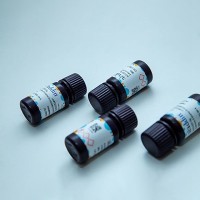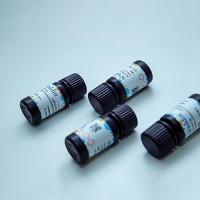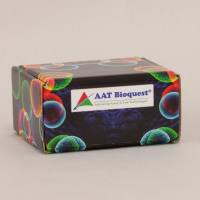Expression Library Screening (Procaryotic) Using AP-Fusion Proteins
互联网
Outline:
Bacteriophage lambda is a linear double stranded DNA, approximately 50 kB in size. The two sticky ends help the phage to recircularize after entering the bacterial host cell. A cDNA library is a representation of mRNA's that are expressed in a certain tissue at a certain time (e.g. rat d9 pseudopregnant decidua). Each phage contains one cDNA that was 'grabbed' by the poly-A tail and cloned into a multiple cloning site within the lacZ gene within the linearized pBluescript SK plasmid ("phagemid") between the initiation site ("I") and the termination site ("T") within the central portion of the bacteriophage lambda between the two "arms" of the phage genome that are crucial for its function. Before screening, the expression library is titered, i.e. the number of pfu (plaque forming units) per ml is determined. Then the library is plated. After the initial formation of plaques, IPTG-soaked nitrocellulose filters are applied to stimulate the lacZ promoter and consequently the protein production. Following an 8 hour incubation, the filters are marked, removed, washed, blocked and incubated with the AP-fusion protein. Then, the filters are washed again and AP substrate (NBT/BCIP) is added indicating the positive plaques. These positive plaques are identified on the original plate, cored, diluted, replated and rescreened until an isolated positive plaque can be recovered. This isolated plaque is transfected into E. coli host cells together with helper phage. This helper phage encodes proteins that excise the bluescript phagemid containing the cDNA insert. The phagemid is recircularized, packaged and secreted from the bacteria. The E. coli cells that were used for this process ("in vivo excision") can be killed by heating at 70°C and removed by centrifugation. The supernatant containing the phagemid packaged as filamentous phage particle is then mixed with fresh bacteria and spread on LBamp plates to produce colonies. The DNA from these clones is prepared by miniprep or maxiprep and finally sequenced using the T3 and/or T7 promoter sequences as primers.
The RNK16 expression library in lambda gt11 needs a different host strain (Y1088, Stratagene #200263), has only one usable restriction site (EcoRI), does not contain pBluescript vector and can not be used for in vivo excision. Primers for gt11 are available from Sigma (forward primer: #P1680, reverse primer: #P1805).
Growing up host bacteria
Reagents:
|
Supplies & Equipment:
|
Procedure:
-
Prepare glycerol stock (can be stored at -20°C for 1-2 years, or at -80°C for more than 2 years)
- From the shipped glycerol stock, scrape of splinters of solid ice with a sterile wire loop.
- Streak the splinters onto an LB tetracyclin (or NZY tetracyclin) plate. (for optimum results, restreak the cells each week)
- In a sterile 50ml conical tube, inoculate 10ml of LB media with 12.5µg/ml tetracycline with one or two colonies from the plate. Grow cells to late log phase in 37°C shaker incubator (usually 6-8h)
- Add 4.5 ml of a sterile glycerol-media solution (5ml of autoclaved 80% glycerol solution + 4ml LB + 9µl 1000x tetracyclin stock). Mix well.
- Aliquot into sterile centrifuge tubes (1ml/tube).
-
Preparation of host cells directly from glycerol stock
- Prepare a sterile 50ml conical tube, containing 10ml of LB media + 100µl of the 20% (w/v) Maltose stock solution + 100µl of the 1M MgSO4 stock solution + 10µl of the 1000x tetracyclin stock solution .
- Inoculate with 25 to 50µl of the glycerol stock.
- Incubate in 37°C shaker incubator for 6-8 hours.
-
Preparation of host cells from single colony
- Streak XL1-blue MRF' cells on LB/tetracycline (12.5µg/ml) plates and grow overnight at 37°C.
- In a sterile 50ml tube, start a culture from a single colony and grow overnight with vigorous shaking at 30°C in 10 ml TB media supplemented with 0.2% maltose and 10mM MgSO4 .
- Spin the cells at 1000g for 10 min, then gently resuspended in 0.5 volumes of 10mM MgSO4 .Cells prepared in this manner can be used for all manipulations. For highest efficiencies use freshly prepared cells.
| 1M MgSO4 stock solution | |||
| Reagent | Final Conc. | Volume | Mass |
| dH2 O | 80ml | ||
| MgSO4 7H2 0 (MW 246.48, Fisher 63-500) | 1M | 24.65g | |
| QS to 100ml with dH2 O, autoclave |
| 20% (w/v) Maltose (100 x) stock solution | |||
| Reagent | Final Conc. | Volume | Mass |
| dH2 O | 80ml | ||
| Maltose (MW 360.32, Fisher M75-100) | 20% | 20g | |
| QS to 100ml with dH2 O, filter sterilize, store at 4°C |
| 1000x tetracyclin stock solution | |||
| Reagent | Final Conc. | Volume | Mass |
| dH2 O | 80ml | ||
| Tetracyclin hydrochloride (MW 480.9, Sigma T-3383) | 12.5mg/ml | 1.25g | |
| QS to 100ml with dH2 O, filter sterilize, aliquot 1ml, store at -20°C, lightsensitive ! |
Expression Library Titration :
- Streak the XL1-Blue MRF' host bacterial glycerol stock onto the LB-tetracycline (12.5 µg/ml) agar plate. Incubate the plate overnight at 37°C. The bacterial glycerol stock may be stored at -20°C for 1-2 years or at -80°C for more than 2 years.
- Inoculate 10 ml LB + 0.2% (w/v) maltose + 10 mM MgSO4 with a single colony.
-
Grow at 37°C, shaking for 4-6 hours (do not grow beyond an OD600 of 1.0).
Alternatively, grow overnight at 30°C, shaking at 200 rpm. Phage can adhere to dead cells as well as to live ones and can lower the titer. - Autoclave the NZY top agar and place in a 50°C water bath for later use.
- Serial dilute the rat d9 decidual cDNA library (from Stratagene with a titer of 1010 pfu/ml) with SM buffer to 5 x 105 , 5 x 103 , 5 x 102 , 5 x 101 , 5, 5 x 10-1 pfu/µl. Store the diluted phage at 4°C (for one month).
- Prewarm the NZY agar plates in 37°C incubator.
- Pellet the bacteria at 2000 rpm for 10 min.
-
Gently resuspend the cells in half the original volume with sterile 10 mM MgSO4 .
Measure the OD600 of the bacteria and dilute to an OD600 of 0.5 with sterile 10 mM MgSO4 (store at 4°C for a week). - Add 2 µl each of the serial diluted phage to 200 µl of XL1-Blue MRF' cells at OD600 of 0.5, incubate the phage and bacteria at 37°C for 15 min. to allow the phage to attach to the cells. (Best results are obtained with gentle shaking).
- Add 2-3 ml of NZY top agar (50°C) to each tube, plate immediately onto the NZY agar plates and allow the plates to set for 10 min. Place the plates upside down in 37°C incubator. Plaques should be visible after 6-8 hours.
Plating Phage
Reagents:
|
Supplies & Equipment:
|
Procedure:
- Agar plates ( NZY tetracyclin plates ) should be prepared at least 24 hours prior to use.
- Grow an overnight culture of bacterial cells (XL1-Blue MRF') in 10ml LB supplemented with 10mM MgSO4 and 0.2% (w/v) maltose to an OD600 of 1.0 (see: " Growing up host bacteria ").
- The next morning, autoclave the Top Agar and place in the 50°C waterbath, let temperature adjust for at least 1 hour.
- Preincubate the agar plates for 1 hour at 37°C immediately before use. This preincubation period reduces the moisture content of the agar plates, which results in higher quality plaque lifts.
- Pellet the bacteria at 2000 rpm for 10 minutes, gently resuspend the cells in half the original volume with sterile cold 10mM MgSO4 , measure OD600, then dilute the cells to final OD600 of 0.5, place on ice.
Screening Plaques with AP-Fusion Protein
Reagents:
|
Supplies & Equipment:
|
Procedure:
- Dilute the 1M IPTG (stored at -20°C) in sterile distilled water to 10mM in the petri dish.
- Wet the nitrocellulose membranes slowly by submersing them in the IPTG solution from the edge.
- Dry the wet membranes on Whatman 3MM paper for at least 30 minutes .
- After drying, label the membranes with a pencil.
- When small plaques become visible (transparent dots), apply the numbered IPTG-soaked membranes to the appropriate agar plates with forceps (touch the middle first and then guide the bubbles to the perimeter).
- Incubate at 37°C for 8 hours.
- Optional: in order to prevent top agar from sticking to the nitrocellulose membranes, place the plates for 2 hours at 4°C .
- Peel off the nitrocellulose membranes and submerse in pyrex dish with 1 x PBS + 0.1% Triton X-100 (1 liter = 50ml 20x PBS + 979 ml dH2 O + 1ml Triton X-100). Wash with gentle shaking for 3 x 5 minutes at room temperature to remove agarose.
- Block with PBS + 2% BSA for 1 hour at room temperature on shaker.
- Prepare incubation solution containing the fusion protein (for AP-PLPx (~100kDa): 650mU ~ 1µg, for 200ml incubation solution concentrate fusion protein to ~650mU/100µl, add 20ml to 180ml PBS + 2% BSA, handle on ice).
- Replace blocking solution with incubation solution. Incubate overnight at 4°C with gentle shaking.
- Wash membranes for 4 x 15 minutes with PBS + 0.1% Triton X-100 at room temperature on shaker.
- Rinse once with AP buffer 2 to adjust pH.
- Submerse in color developing solution (
In vivo Excision
Reagents:
|
Supplies & Equipment:
|
Procedure:
- Core the plaque of interest from agar plate and transfer it to a sterile microfuge tube containing 500µl of SM buffer and 20µl of chloroform. Vortex the tube to release the phage particles into the SM buffer. This phage stock is stable for up to a year at 4°C.
-
In a 50ml conical tube combine:
-
200µl of OD600 =1 XL1-Blue cells
(best if grown up fresh, because phage also attaches to dead bacteria, most important during early screening, less important during tertiary and later screening because of highly abundant signal) - 200µl of phage stock from step 1 (containing >105 phage particles)
- 10µl of R408 helper phage (106 to 1011 pfu/ml)
Incubate mixture for 15 min in waterbath at 37°C.
Note: suggested negative control: Add XL1-Blue cells and helper phage alone, no recombinant phage.
-
200µl of OD600 =1 XL1-Blue cells
- Add 5ml of 2xYT media and incubate 3-6 hours at 37°C with shaking.
- Heat tube in 70°C waterbath for 20 minutes, then spin tube for 5 minutes at 4000g.
- Decant supernatant into a sterile tube. This stock contains the pBluescript phagemid packaged as filamentous phage particle and can be stored at 4°C for 1-2 months.
-
To plate the rescued phagemid, combine the following in two 15ml tubes:
- 200µl of phage stock from step 5 above and 200µl OD600 =1.0 of XL1-Blue host cells
- 20µl of a 1:100 dilution of phage stock from step 5 above and 200µl OD600 =1.0 of XL1-Blue host cells.
Incubate tubes for 15 min in waterbath at 37°C.
- Plate 1µl to 100µl on LBamp plates and incubate overnight at 37°C. White colonies on the plate contain the pBluescript plasmid with the cloned DNA insert.
Additional considerations:
- The number of rescued colonies increases linearly with increased incubation time in step 3. If low numbers of colonies are rescued, increase the incubation time.
- Rescue efficiencies are directly related to the lambdaZAP II phage titer. If a rescue is unsuccessful, it may be necessary to make a high titer stock of the phage for the rescue procedure. About 10,000 phage are required for a successful rescue using the above protocol.
- Helper phage titers make little difference in rescue efficiencies. However, it was observed that different helper phage strains contain up to 10 fold variations in the rescue efficiency. A variety of helper phage strains are available from Stratagene. R408 is recommended for its stability during preparation of the helper phage stocks.
- If ampicillin resistent colonies grow slowly, it may be due to the presence of helper phage in the cell. Helper phage can be easily removed by increasing the ratio of bacteria to phage during the plating in step 6 above.
References:
- Sparks, A.B., Hoffman, N.G., McConnell, S.J., Fowlkes, D.M., and Kay, B.K. Cloning of ligand targets: Systematic isolation of SH3 domain-containing proteins. Nature Biotechnology 14:741-744, 1996.
- Sparks, A.B., Quilliam, L.A., Thorn, J.M., Der, C.J., and Kay, B.K. Identification and characterization of Src SH3 ligands from phage- displayed random peptide libraries. J.Biol.Chem. 269(39):23853-23856, 1994.
- Sambrook, J., Fritsch, E.F., and Maniatis, T. Molecular Cloning. A Laboratory Manual , Cold Spring Harbor, NY:Cold Spring Harbor Laboratory Press, 1989.







